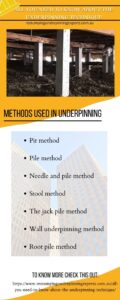- By spizspy
- In Underpinning
All You Need to Know About the Underpinning Technique
Are you thinking about getting rid of those cracks, building a basement or deepening the depths of your already existing foundation?
Well, though sensitive, the underpinning technique is the answer to all your questions.
The Underpinning Technique: What Does it Mean?
Underpinning is a technique used in construction to make the already existing foundation of a building deeper and stronger than it is in its current form.
This is usually done by laying a fresh foundation below the current one to strengthen it.
This technique, even though sensitive, serves a lot of purposes.
Reasons for Underpinning in Construction
Underpinning is needed when;
- You want a basement constructed under an already existing building
- A constructor needs to deepen a foundation to make it stretch deeply in better layers of soil
- One wants to maintain or keep a foundation that shows signs of cracks in good condition
- Constructors want to put up a building with a deeper foundation from the already existing with a shallow one
Methods Used in Underpinning
Below are some of the methods used to underpin out there;
- Pit method
- Pile method
- Needle and pile method
- Stool method
- The jack pile method
- Wall underpinning method
- Root pile method
Here we are going to see two of the most acknowledged underpinning methods in the construction industry.
1. The Pit Method
This method is also known as the mass concrete method. In this method, work is done in sections. The columns used in the pit method are shorter compared to the ones used in other techniques.
Step1
The length of the foundation that is to be underpinned is divided into regular sections with the measurements of 1.3m:1.5m.
Each section is taken up one after the other.
Step 2
A hole is drilled into the foundation wall of the divided sections just above the plinth level.
Step 3
A needle, either made of steel, timber or stout is then inserted into the hole. To hold up the foundation and the Mansory on top, the needle is attached to a bearing sheet.
For the support system to be effective, the needle’s arrangement is made of wooden blocks on each side of the wall and fastened jacks.
Step 4
Here, the foundation trench is excavated according to the required level and the fresh foundation is laid underneath the pit.
At this point, the first section is done. The second section is later on taken up.
Some precautions should be taken into consideration. For example, floors should be supported and weak walls provided with raking shores.
2. The Pile Method
Here, the foundation pile also known as the piers are, by proper driving procedure, installed along each side of the wall to be strengthened at an equal length.
This is normally done to transfer the weight of the building away from the unstable concrete.
Thereafter, needles made of concrete or steel are driven into the walls where they connect to the piers.
The needles here have a crucial role to play. They act as beams and caps at the same time.
Advantages of Pile Method
The pile method is suitable in areas with;
- Erosive, waterlogged and clayey surfaces
- Expansive and weak bearing layers
Conclusion
There are some signs to look for once in doubt of whether you need underpinning or not. Below are some: Go for underpinning if;
- You notice some cracks on the floors and walls
- Your floor is not levelled
- The doors and windows are not aligned
However, it is always wise to seek help from the experts in underpinning near you.

